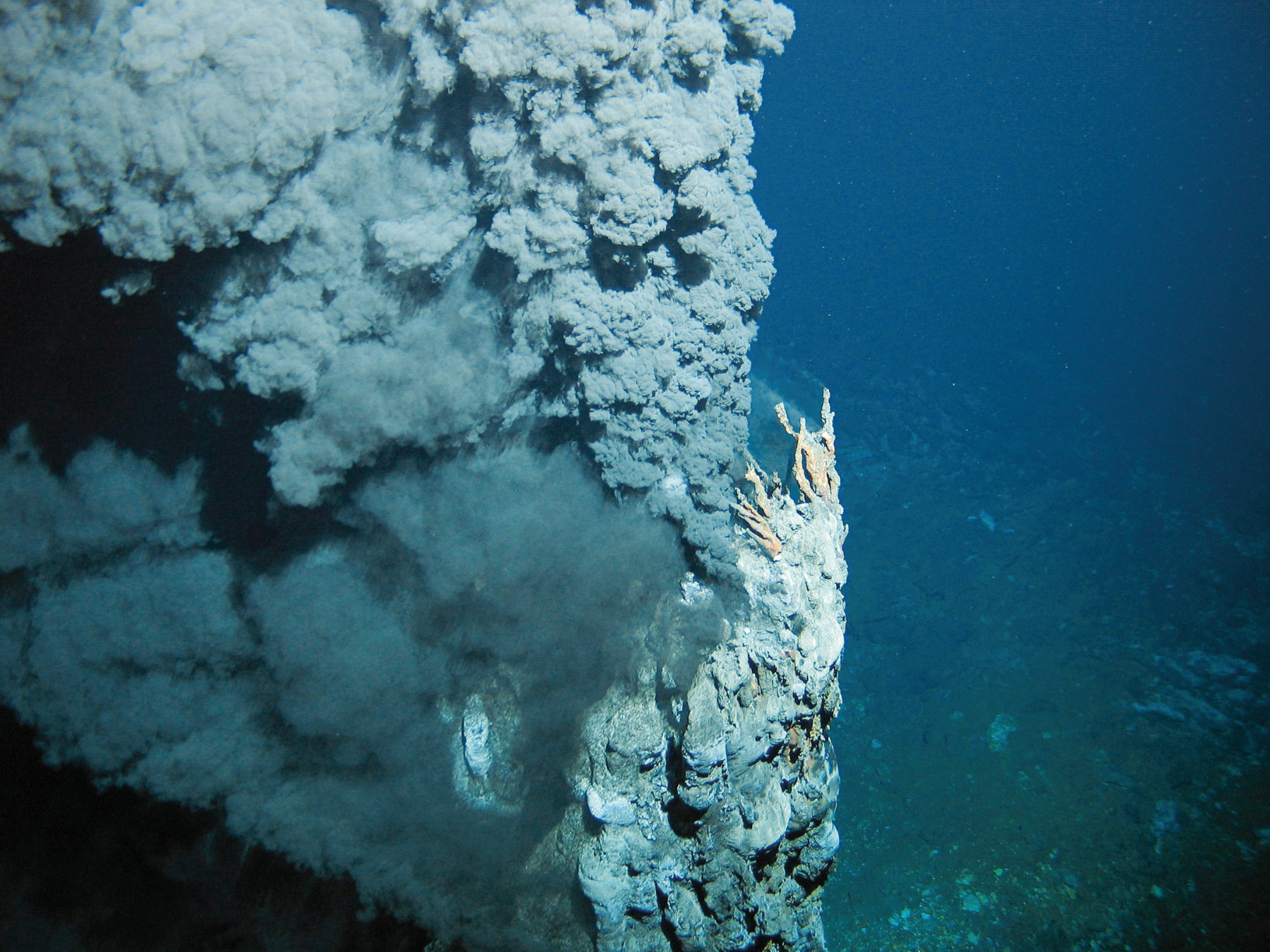It is impossible to imagine a sustainable Earth without a sustainable ocean. Kiel research is pointing the way to both.
Kiel scientists carry out research in all the world's ocean basins, and are expert in understanding their past and present as well as in modelling their possible future states. Experts from the Kiel Cluster combine insights from physics, chemistry and biology with social, economic, legal, and ethical assessments. Their work is a world-leading example of trans- and interdisciplinary research informing current and future ocean use.
Scientific findings are increasing our awareness of the risks posed by our current use of the ocean. Kiel scientists investigate how future needs for marine food production can be met sustainably, either by means of fisheries or through aquaculture. They increase our understanding of the long-term risks resulting from ocean acidification. They are also investigating and assessing proposals for deep-sea mining of metal nodules, taking into account how intrusive and devastating this new technology might be. And they are looking at the case for and against marine climate intervention, the possible deployment of ocean-related technologies intended to counteract climate change. All of these examples involve value judgements, and these are addressed in Kiel by ethical reflection on underlying values and principles.
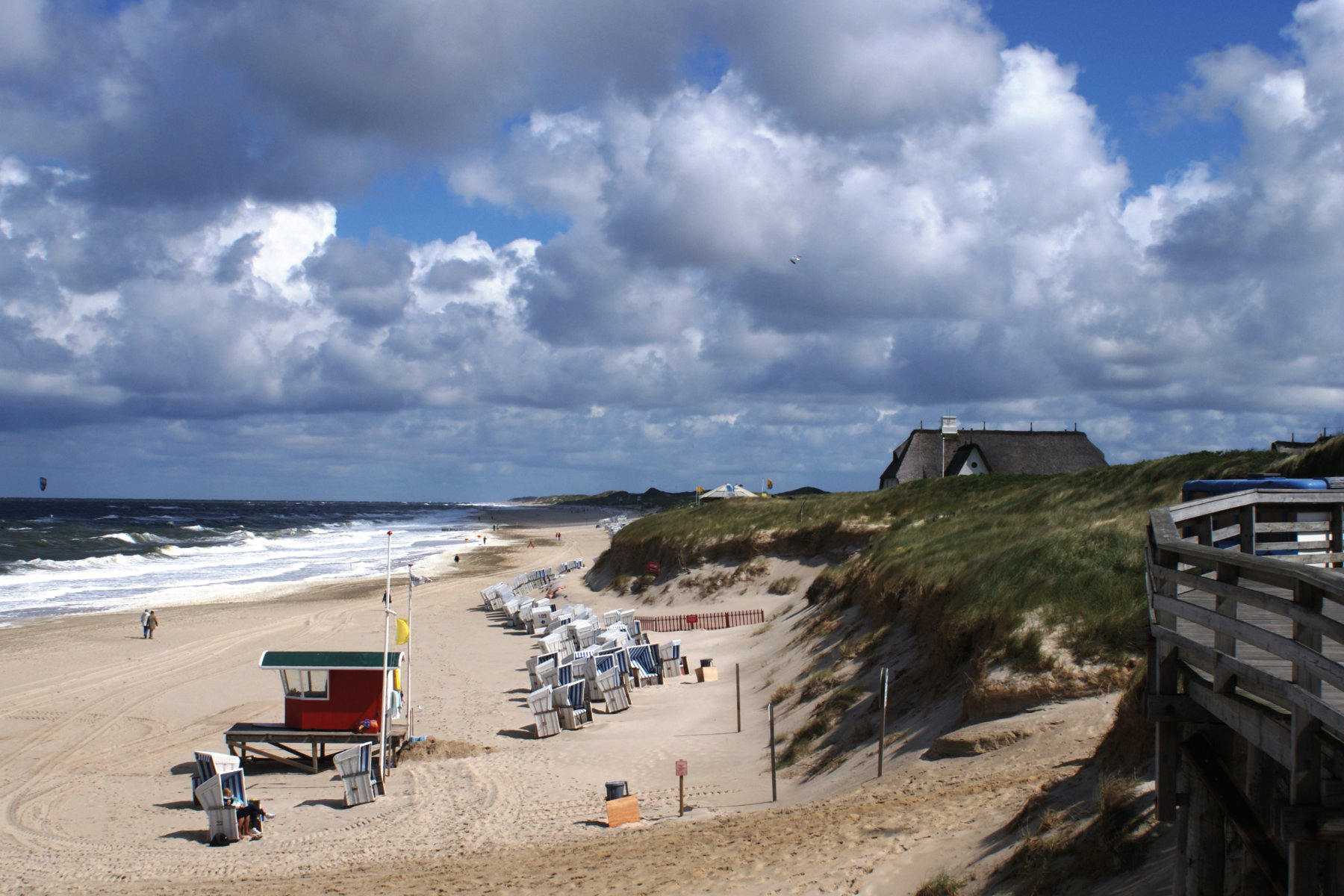
Integrated marine research in Kiel works on assessments and solutions for the sustainable use of the ocean. And it is improving ocean literacy through publications like the World Ocean Review and the Ocean Atlas.
Kiel research produces proposed solutions which are intended for consideration and use. They will help societies, and in particular coastal communities, to become more sustainable, resilient and even prosperous, and they encourage people to become more aware of the issues. Kiel researchers carry out a broad range of educational outreach, making use of novel digital resources. Through our own work and our collaboration with noted artists, we are able to bring the unimaginable world of the deep ocean to life for a wide range of audiences.
Kiel's research is increasingly engaging with individuals, businesses, non-governmental organisations and policy makers of all kinds. It maintains contacts with coastal communities in many parts of the world and works with them to reflect on solutions to see if they are ethically and legally sound as well as being scientifically and technically feasible.
What is the link between sustainable development and living in harmony with the ocean? What problems do we need to solve if we are to achieve a sustainable ocean? Can new technology improve the way we use the ocean? How can art and other imaginative forms of communication help tell ocean stories? What governance systems might make our use of the ocean more sustainable?
Global ocean literacy will help develop support for solutions to ocean sustainability, one of world society's most urgent problems. In order to grow this support, interdisciplinary research at Kiel is taking on a new and more comprehensive approach. Its remit now ranges from discovery and understanding to the assessment of research findings and issues, and on to the generation and consideration of solutions to urgent problems facing genuine sustainable development.

The ocean and sustainable development
The 2030 Agenda for Sustainable Development and its 17 Sustainable Development Goals (SDGs) were adopted by the United Nations in 2015, including one SDG number 14 devoted to the seas and oceans [1]. Kiel researchers led by Martin Visbeck contributed to the UN discussions that created the SDGs and supported the development of SDG 14 [2,3]. But what does it mean in practice? Humankind and the oceans form a single interacting system. Researchers at Kiel - with backgrounds in disciplines ranging from economics to oceanography - have looked at what they term the health of the system and how to measure it. Since "health" is itself a metaphor, the vision of a "healthy" ocean must be specified in scientific terms such as resilience, productivity and diversity.
Kiel researchers have critically observed and assessed global approaches to measuring sustainable ocean development, as proposed for example by Halpern et al. (2012) [8] through the development and annual updating of the Ocean Health Index. This work is a seminal contribution to better understanding and management of the human-ocean system. However, Kiel scientists have shown that precautionary and sustainable ocean governance requires the social evaluation of ocean benefits, and of the risks and uncertainties involved in our interaction with the ocean. This points to issues of concern with an index of ocean health that has unlimited substitution possibilities, so that a healthy result in one area can compensate for poor performance in another, such as the Ocean Health Index. Policy assessments carried out in this way could certify the health of the human-ocean system for countries that neglect important aspects of ocean health, and might wrongly identify damaging development trajectories as sustainable.
These insights also suggest that we need a better way of measuring progress against SDG 14, the Goal which emphasises the health of the oceans and the life they contain. An interdisciplinary Kiel research team led by Wilfried Rickels, and including economists as well as physical scientists, has tackled this issue.
The group has looked at the implications of SDG 14 for the waters around the nations of the European Union. One complicating factor is that the 17 Sustainable Development Goals have within them 169 specific targets. According to Rickels and colleagues, this large number of objectives means that the SDGs are bound to involve many synergies and trade-offs. Their sheer number also shows that innovative policies and management approaches will be needed to achieve the SDGs by the target date of 2030.
Health of Europe's waters
Their approach to seeing whether SDG 14 is being achieved in European waters involves looking at the status of 17 indicators of sustainable ocean use. They range from the recovery of plastic packaging, a major pollution threat to the oceans, all the way to threatened fish and other animals. The findings suggest that Germany and France have the healthiest seas, while Bulgaria and Greece are the least successful at marine sustainability.
How does international law react to environmental change?
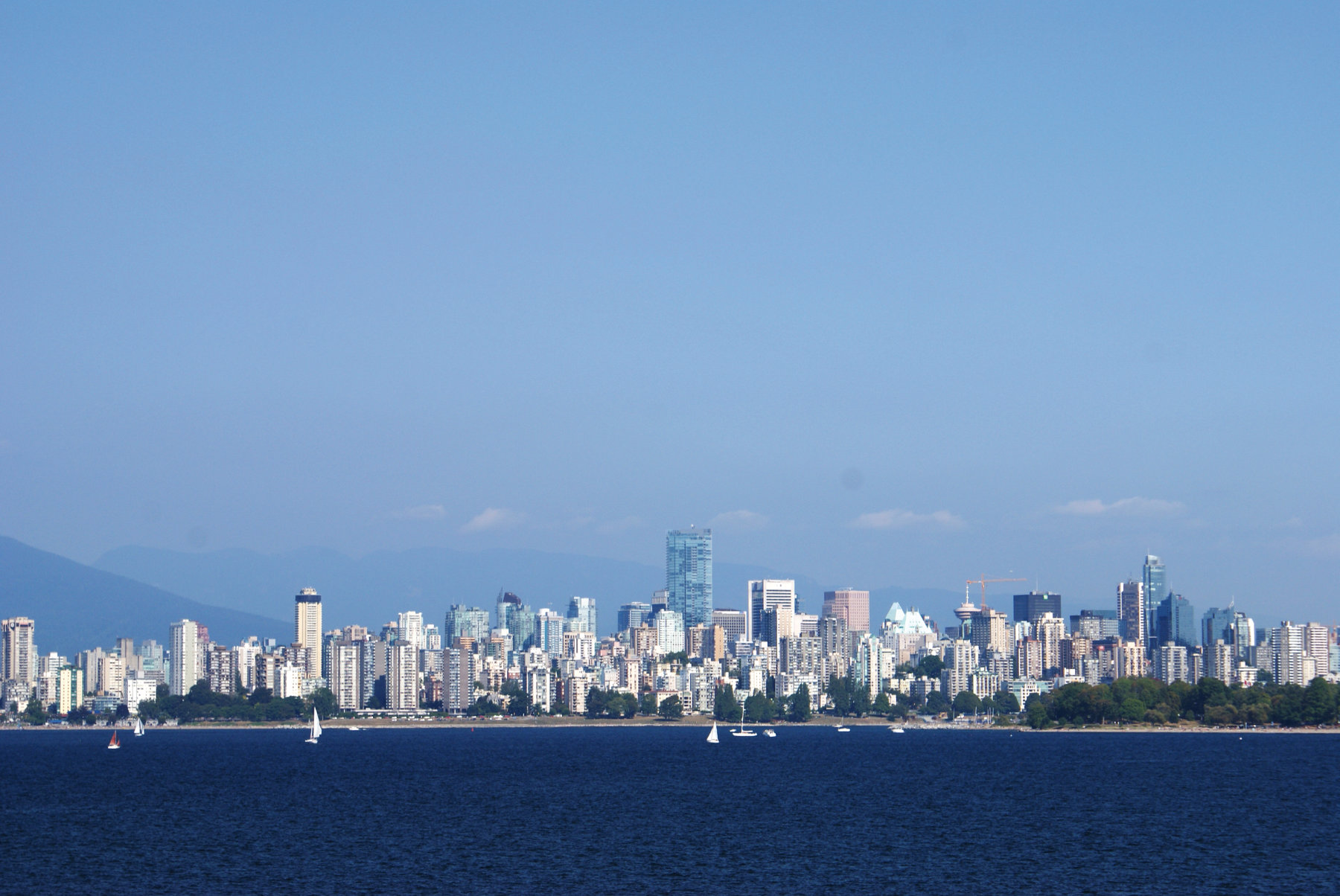
As the Earth gets warmer, sea levels are rising around the world. And because the ocean takes time to respond to global warming, they will continue to rise even if we act soon to prevent further climate change. This calls for new political, diplomatic and legal solutions as well as
scientific ones.
This issue is important. It involves large populations as well as big economic costs. In addition, we now appreciate that global average figures for sea-level rise do not tell us what will happen along a particular stretch of coast. Better ocean observations are essential if we are to map and predict the very variable effects of sea-level rise in different parts of the world [7].
International courts have indicated that changes in the actual coastline of a state will affect the location of the baseline as defined by the international law of the sea. An island does not have to vanish beneath the waves to lose its legal standing as the outermost marker of a state, but merely has to become uninhabitable.
For example, sea-level rise would cause extensive loss of land in Florida and in neighbouring Caribbean islands, but would have far less effect on the coastline of Cuba. This might feed demands for Cuba's maritime zones to expand at the expense of its neighbours, including the United States, in delimitation cases between them.
Legal scientists also point to the situation of India, Bangladesh and Myanmar in the Bay of Bengal. It could be India that suffers the most severe loss of dry land, which could drive Bangladesh to claim larger areas of ocean as zones under at least functional jurisdiction, an aspect which is important for exclusive rights over fisheries and non-living resources on the seabed.
As a consequence of sea-level rise, migration too becomes a wicked problem. The concept of climate-induced or environmental refugees is ill-defined and responsibility for displaced persons is unclear. Worldwide, millions of people are moving towards coastal regions just as the climate-induced risks increase in such areas. The ethical topics involved in these dilemmas are at the intersection of climate ethics, the ethics of migration, and ocean policies.
Their approach allows trade-offs between different indicators to be assessed, identifying countries which have an unbalanced performance across the indicators. The different indicators are assigned equal weight in the calculation and the substitution possibilities are limited, allowing development to be assessed against the criteria of strong sustainability. In addition, the assessment is not restricted to ecological indicators, but also takes into account the other dimensions of sustainable development. For example, it might be ecologically desirable to close a fishery for some years so that it can recover its population level. But that recovery would come at the cost of reduced short-term earnings from the fishery and the potential loss of economic capital, preventing other forms of sustainable development. Accordingly, the group points out that sustainable development is not necessarily the right objective for all ocean-related governance decisions. Policy makers should aim for solutions that help fisheries achieve transformation with both increased fish stocks and modernised fishing fleets, even if the goal of sustainable development is violated temporarily.
Furthermore, Kiel researcher Barbara Neumann et al. (2017) argue that the sub-targets of SDG 14 implicitly presuppose a concept of strong sustainability that makes the preservation and restoration of depleted natural capital mandatory for the sake of future generations.
Kiel research is therefore central to reforming our existing systems of ocean governance. The present approach is too weak and fragmented to support improved ocean management.
Improved ocean governance and policies, and the tools to implement them are needed, because of the potential [4] for damaging disruption of the ocean. If the oceans are destabilised, ecosystems and coastal societies are put under pressure, with the loss of human life, of marine habitats, and of infrastructure. Kiel research is helping to develop risk management strategies that are based on a thorough understanding of the chain of events that can trigger ocean disasters, as well as their progress and their impacts on land. This approach will lead to increased ecological and social resilience and so contribute to human prosperity.
Ocean restoration?
Kiel research on climate intervention described in these pages suggests that there is little justification for attempts to alter the Earth’s atmosphere, or for adopting other artificial means of cooling the Earth.
But one team of Kiel scientists is examining some limited approaches to preventing or reversing the damage being done to the oceans by growing atmospheric concentrations of carbon dioxide, while another is researching ways of making the oceans more valuable to mankind.
A group led by Andreas Oschlies at Kiel has looked at possible ways of counteracting the damage done to coral growth in tropical oceans by the increasing amount of carbon dioxide dissolved in seawater. The extra carbon dioxide makes water more acidic. This may reduce the ability of some animals to secrete their shells, and is also affecting animals that do not grow a shell.
It may be feasible to add calcium hydroxide, an alkali, to seawater to reverse its growing acidity. Taking established models of the ocean and atmosphere as their starting point, Oschlies and colleagues looked at the effects of adding calcium hydroxide to the top 50m of sea water in the region of the Great Barrier Reef off Australia, in the Caribbean, and in the South China Sea.
They found that this tactic could work, but would involve over 300 billion tonnes of material being injected into the ocean over 80 years. This intervention would have a range of desirable and less desirable effects. Calcium carbonate could be created in the water and make it cloudy, which is not good for coral growth. It would also cost up to about $600 billion a year, and the positive effects would cease rapidly if the supply of alkali to the sea were to cease. This expenditure represents an opportunity cost which could also be spent on other goals.

Another ocean technology being examined at Kiel is inspired by the natural upwelling of seawater. A €2.5 million project led by Ulf Riebesell is evaluating the possibility of inducing more such upwelling.
In parts of the ocean, cold, nutrient-rich water wells up to the surface and gives rise to the most productive marine ecosystems. Accounting for less than two per cent the Earth’s ocean area, they contribute over 20 per cent of marine fish catches. If more such upwelling could be induced, fish production could be enhanced and pressure on existing fish stocks could be reduced. At the same time, upwelling of cold deep water would cool the atmosphere, helping to mitigate global warming.
The project, called Ocean artUp, is assessing the benefits of forced ocean water upwelling, but will also address the possible risks and side effects for marine ecosystems.
Riebesell’s group will be gaining knowledge from experiments at all scales, from small simulations of artificial upwelling to field tests at the Plataforma Oceánica de Canarias (PLOCAN) ocean platform off Gran Canaria. Of special importance are “mesocosms,” self-contained marine environments in which conditions can be controlled to allow the ecological impacts of upwelling to be assessed.
The group has developed a deep-water collector capable of collecting 100,000 litres of water at depths down to 800 meters in a giant plastic balloon. This water will be added to the mesocosm enclosures to simulate artificial upwelling, allowing the researchers to follow the response of the surface layer communities to this intervention.
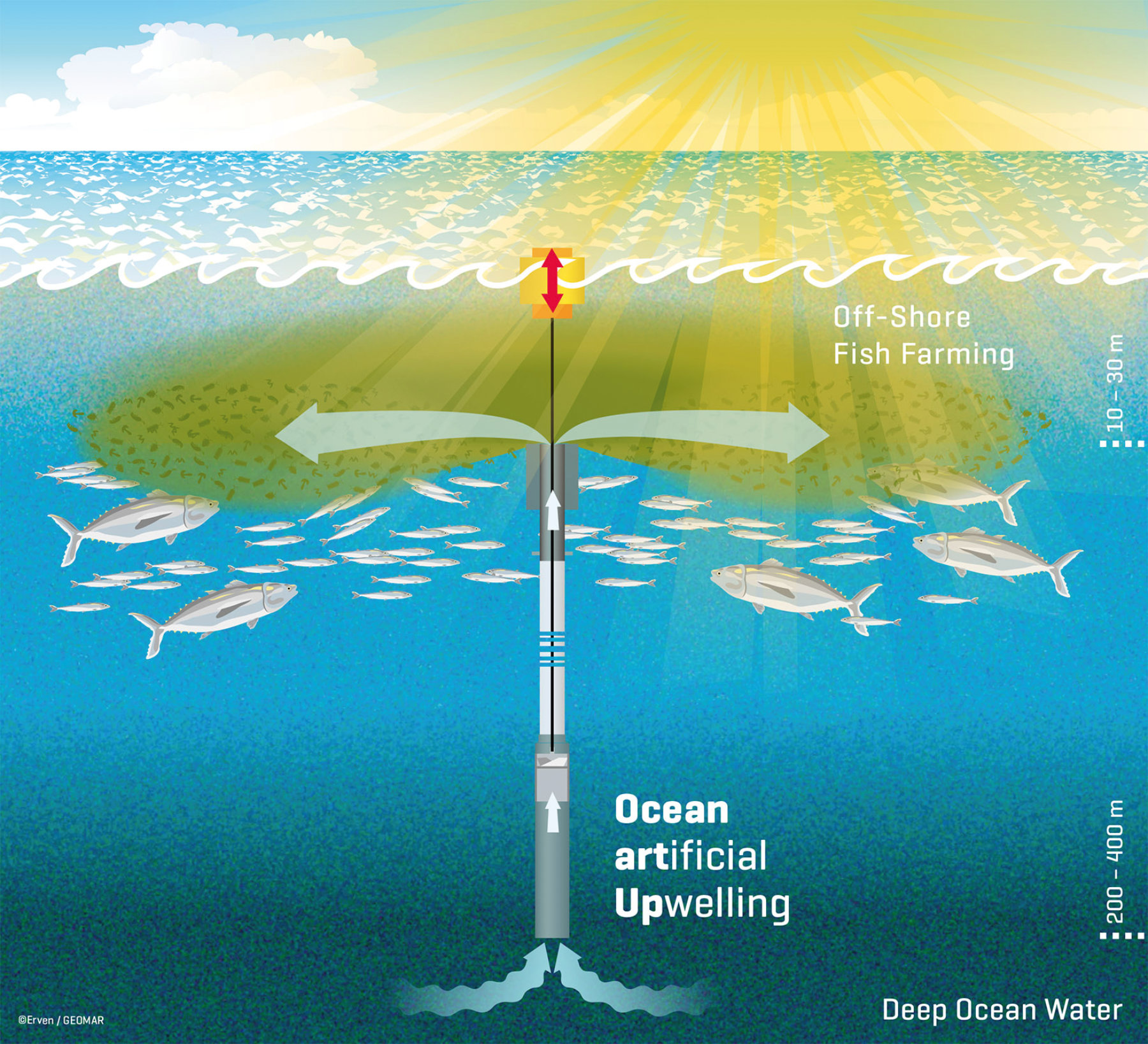
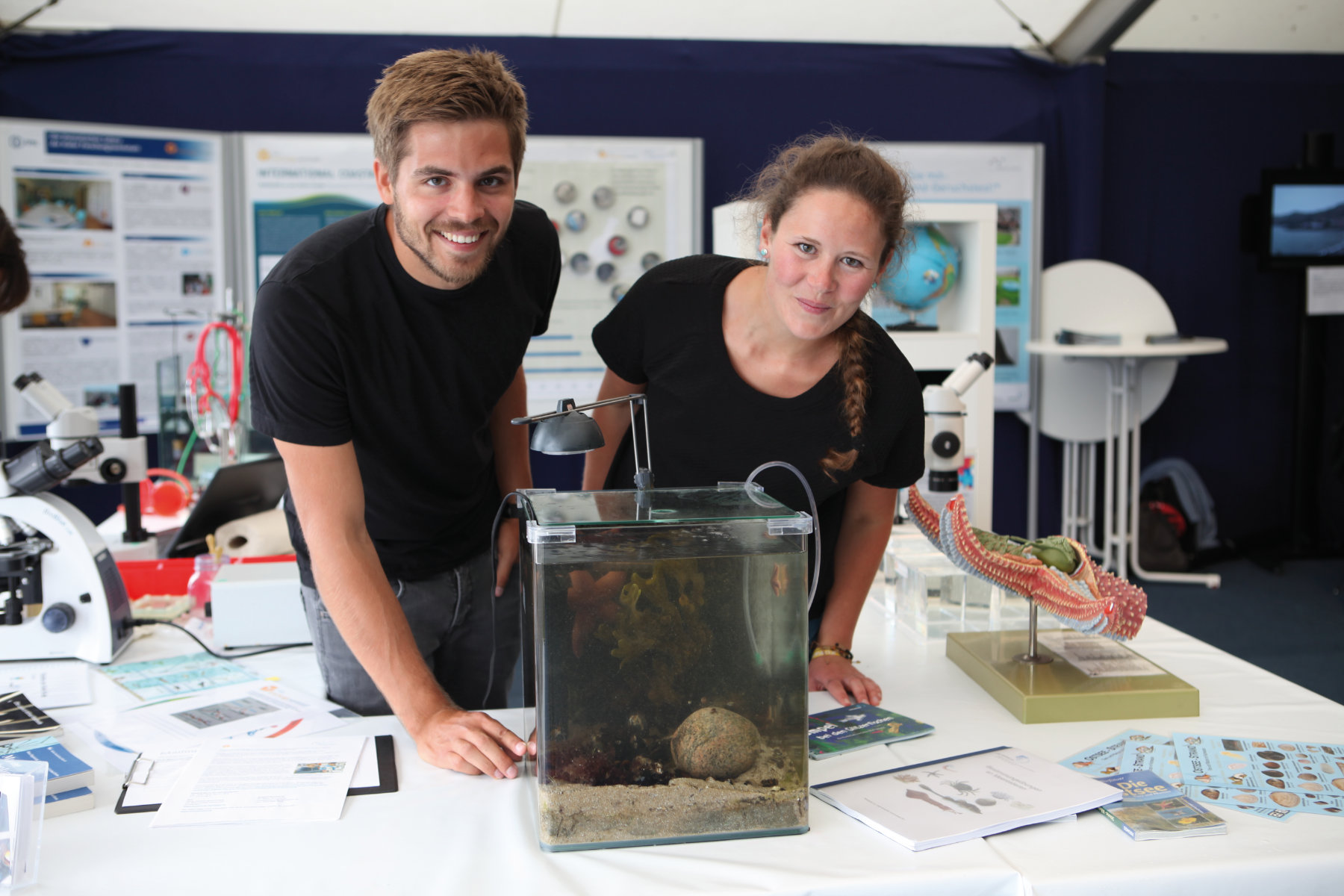
Ethical offshore mining?
One controversial example is the possibility of mining the mineral resources of the deep ocean. Many nations, including Germany, anticipate exploiting gas hydrates, polymetallic nodules, and massive sulphide resources there. This exploitation will add to the pressures on poorly-understood deep-sea environments. Kiel researchers are leading experts in this area, with expertise in policy and international law as well as ocean science. They have experience and international networks in this field, and have led national and EU projects on seabed resources. They have also established close collaborations with industry, environmental NGOs, and regulators, and have created the technology needed to evaluate deep-ocean environments. Deep-sea mining will almost certainly be contested on environmental grounds, since we know that onshore mining has many impacts on ecological systems. The burden of proof falls onto the companies and authorities that regard deep-sea mining as feasible and sustainable.
Martin Visbeck says that Kiel marine research is producing three types of solution to today’s issues in science and human development. Its first positive effect is to generate “ocean literacy,” the ability to understand the ocean and factor it into social thinking. According to Visbeck, this is itself a solution to an important problem, the low level of public engagement in ocean issues.
The Cluster has produced a wide range of publications as part of its work in this area, including the World Ocean Report on Sustainability and the novel Ocean Atlas (see box). There is also a Massive Open Online Course [4]. Formats are being developed to get Kiel research more widely appreciated in the developing world, including in Africa. Visbeck adds that Kiel’s work on the ethics of ocean use adds a deeper level to its outreach work and takes it beyond the “understanding of science“ approach. Environmental ethics has recently informed Kiel research on ocean acidification; cultural services at the Baltic Sea; ocean restoration and recovery; and climate change and environmental migration as it affects small island states.
Visbeck says: “This work is especially important when we engage with people who have authority over ocean-related actions, in business or government, or in the engineering community. We do science that will engage all these type of actor.”
After this, says Visbeck, comes the second stage, Kiel’s work on developing scientific and technological solutions. He says: “We are developing systems that get ocean eddies to draw more carbon into the deep oceans. We are also working on less environmentally-damaging aquaculture foods.”
The third type of solution, and for Visbeck the most satisfying, involves using research to generate transformational behaviour in society. He says: “How do we get society to accept the need to fish less; or to become ecotourists; or to favour marine reserves and artisanal fishing rather than industrial fishing? Our work now is increasingly about changing attitudes.”
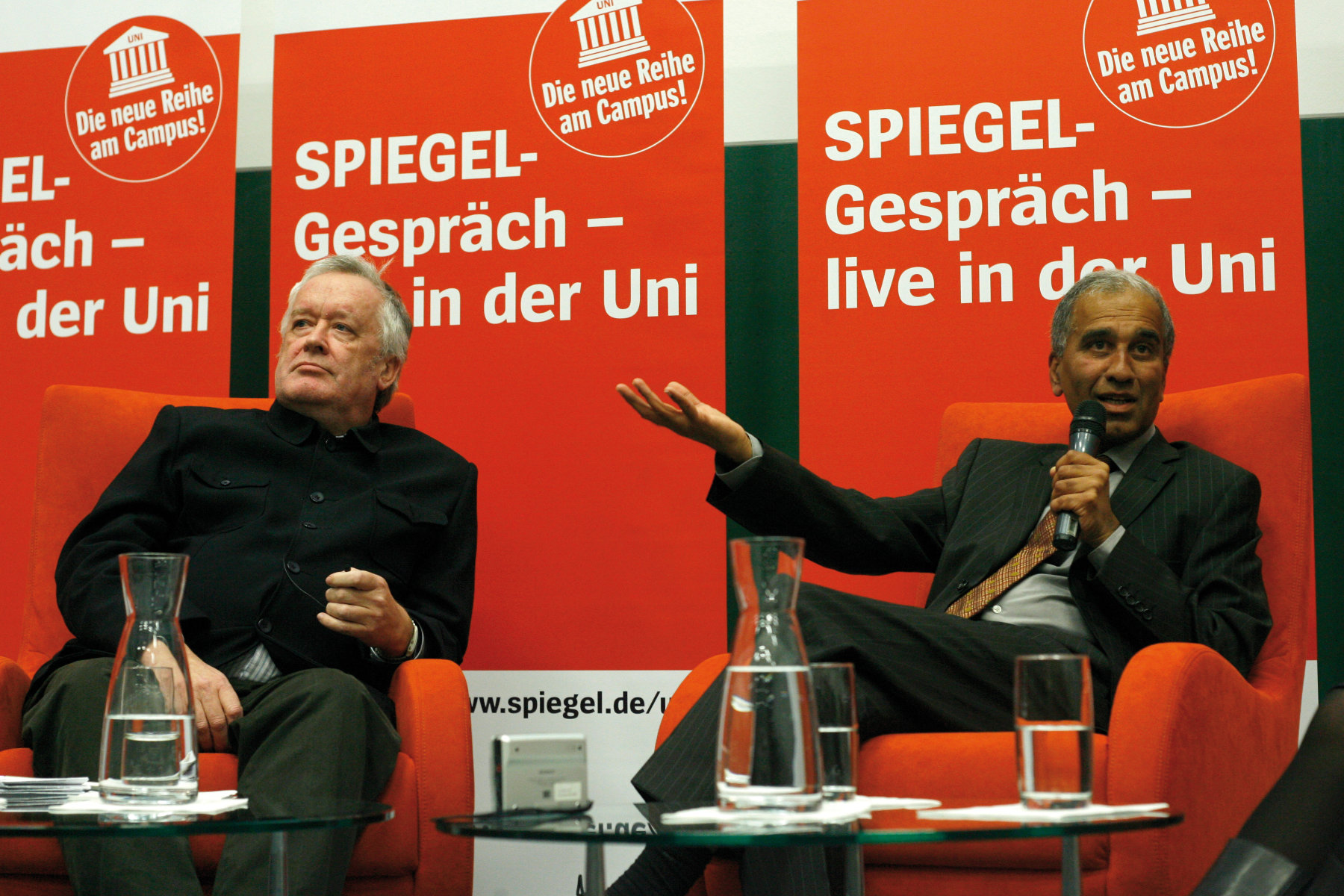
Engineering sustainability?
Our growing awareness of climate change has led to a range of proposals for engineering the atmosphere to combat the impacts of climate change. Collectively termed geoengineering or climate intervention, these schemes range from putting mirrors in orbit to divert sunlight away from the Earth, to pumping water from the depths of the Arctic Ocean to encourage sea ice to form, or fertilising the ocean to increase its capacity to absorb carbon dioxide from the atmosphere.
There are two main approaches to climate intervention: solar radiation management, and carbon dioxide removal. Both groups of technologies have highly specific effects. Most experts agree that climate engineering cannot replace deep and rapid cuts in emissions, but some propose using them to buy time by complementing emission abatement temporarily.
However, a group of researchers, including climate scientists and specialists in law, government and the humanities, have cast doubt on these drastic approaches to modifying the environment. The group, whose members include Kiel’s Konrad Ott, write that “There is no emergency argument for climate engineering.” [5]
Climate intervention has been proposed as a way of avoiding major, damaging events in the Earth’s climate evolution, often termed “tipping points.” Possible examples include the catastrophic collapse of the West Antarctic ice sheet. The problem is that even these planet-altering events do not happen overnight. They occur over decades and there would probably never be a point at which climate intervention could be used to stop them.
The authors add that global warming is likely to cause big social and economic disruption. It would be hard to cure these through climate intervention. Climate change could damage global supply chains for food and other vital resources. These routes are thousands of kilometres long and involve complex flows of materials and information.
In addition, the authors warn that cutting the amount of solar energy entering the Earth’s atmosphere, a favourite target for geoengineering proposals, might have unpredictable effects that outweigh the intended benefits. These might include changes in the jet stream, which influences the weather across heavily populated areas of Europe, Asia and North America. Or it could alter the monsoon, which is vital for agriculture throughout South Asia.
They conclude that despite its apparent potential, “The climate emergency narrative as an argument for (reducing solar energy at the Earth’s surface) must be constantly scrutinized. There are many tragic examples of where normal politics has been suspended in the name of science and ‘objective evidence’.”
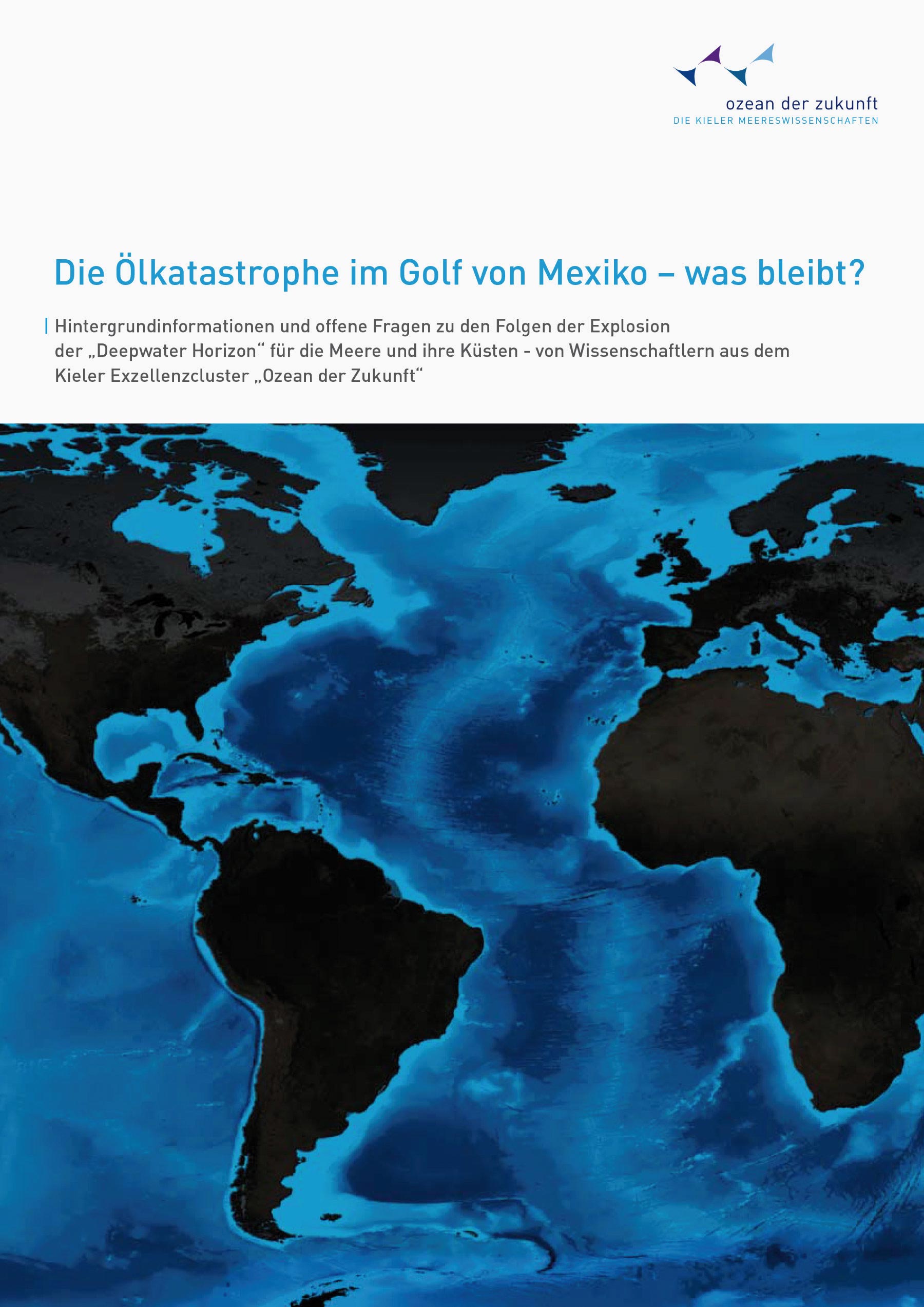
Restoring natural capital
It may be hard to reconcile climate intervention with Strong Sustainability (see previous chapter), a key concept originally developed by Herman Daly and now enhanced by Konrad Ott and colleagues in Kiel. Strong Sustainability argues for decisions to be taken that preserve and restore the natural capital of specific environments, rather than trying to reinvent them for a different future. According to Strong Sustainability, rapid and substantial cuts in greenhouse gas emissions can address the root causes of many ocean-related problems such as warming, acidification and sea-level rise, while climate engineering just addresses the symptoms. Address the root causes of ocean related problems; preserve remaining stocks and funds of natural capital; release pressure from marine and coastal systems; and restore and recover depleted natural capital - these maxims define a comprehensive strategy for the ocean based on the logic of Strong Sustainability.
Alexander Proelss, professor of international law at Trier University and formerly at Kiel, adds that there is very little legal basis for altering the Earth’s climate [6]. Most international treaties on air pollution are too modest in scope to govern the deployment of major climate-altering technology. Indeed, the use of this technology might itself be regarded under existing law as a form of air pollution, although his reading of current international law also suggests that geoengineering is not specifically illegal. In any case, he adds, the generally-accepted precautionary principle discourages climate intervention by making it essential to consider the possible down side of any innovation.
This makes it likely, he says, that the solution to the dilemma lies in the hands of individual states, not global organisations. Nations will probably have to take responsibility for specific geoengineering measures, in consultation with the broader international community and with global opinion.
Martin Visbeck points to climate engineering as a case of Kiel interdisciplinarity in action. He says “We do not do engineering experiments in the field, for instance on seeding the oceans with iron,” one proposed approach to enhancing carbon capture in the oceans. Instead, “We look at legal, moral and ethical aspects and ask if something is economically or societally feasible. Our approach has influenced the German programme in this area.
“If we release carbon into the atmosphere and cause global warming, that is happening by accident,” he explains. “But if we do geoengineering, the effect is intentional. So we need to think about the legal and moral regime in which we do it.”
Nele Matz-Lück, an international law expert in the Kiel Cluster, adds: “The ocean is the biggest store of carbon on Earth, but it is not mentioned in the Paris Agreement on climate change. So there needs to be debate around ideas such as using iron to fertilise the ocean and capture more carbon, or enhancing carbon sequestration in seabed geological formations. Discussions on the Sustainable Development Goal for the oceans may involve these issues, in terms of protecting the oceans from adverse effects as well as capturing more carbon there.”
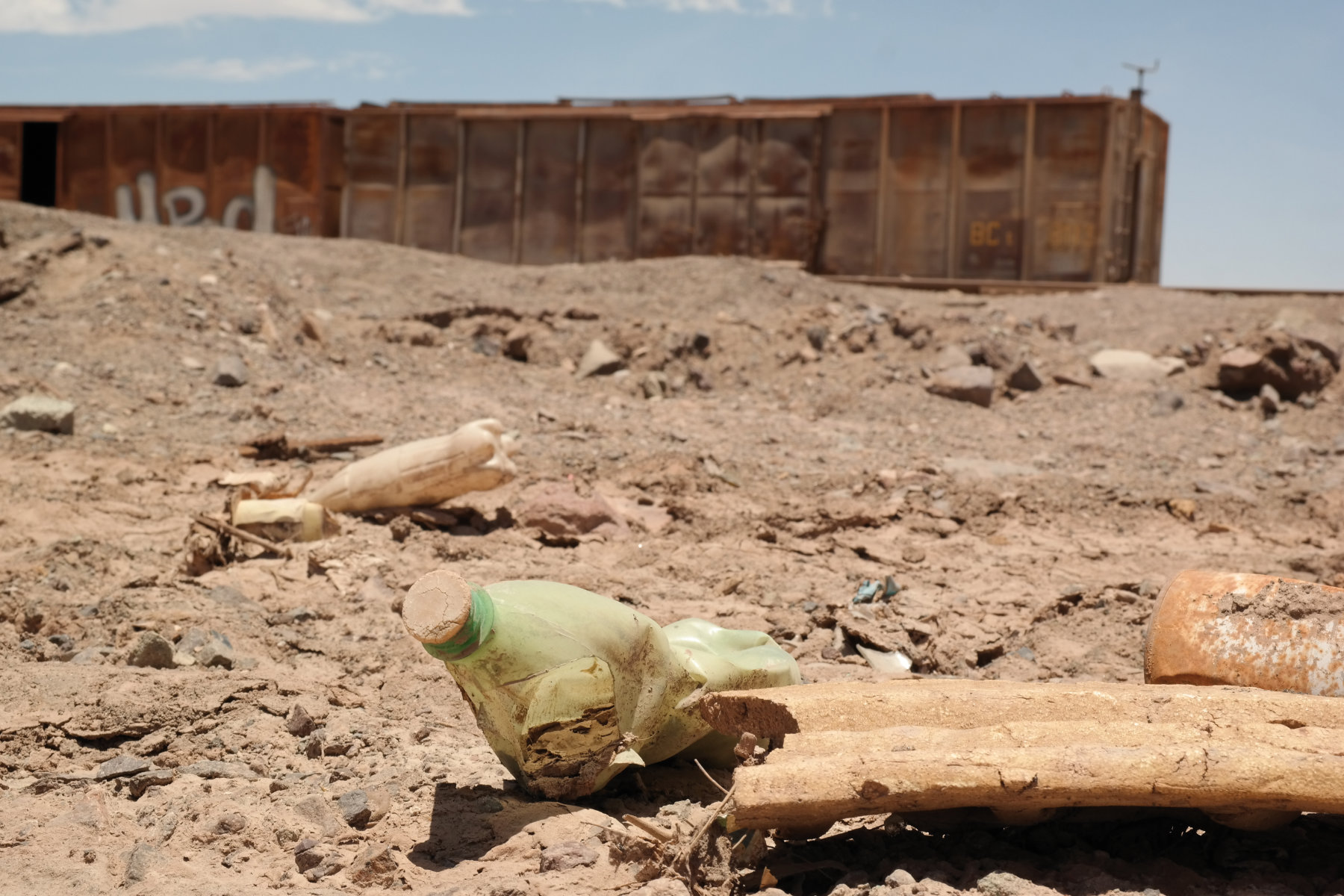
Is this the future? Once the ocean is gone, all that remains is desert and litter.
Improving Ocean Literacy
There is a growing amount of information on the oceans. But we are still a long way away from a comprehensive account of the key issues raised by our use of the oceans for the future of humankind, and for the seas and oceans themselves. The Future Ocean Cluster has taken up this challenge through a range of initiatives.
The most recent is the Ocean Atlas, published online and on paper in collaboration with the Heinrich Boell Foundation. This highly-illustrated 52-page document is subtitled “Facts and Figures about our relationship with the Ocean.” The Atlas is intended for users from school age upwards. Its current, first edition, published in May 2017, contains chapters on the whole range of ways in which people and the oceans interact, from plastics pollution to overfishing, via sea level rise and pollution.
As might be expected for a report from the Kiel Cluster, the Atlas stresses human interaction with the ocean for tourism and other purposes, and investigates the legal and political problems that must be solved for the oceans to be governed fairly and sustainably. Take a look and download a copy from ocean-atlas.org.

The Cluster also has a strong interest in speaking to informed audiences in business, policy, the media and elsewhere. To enhance this effort, it has worked with the International Ocean Institute, a non-profit body based in Malta, and its marine-themed magazine mare, to launch the annual World Ocean Review.
Each issue of the review goes into a specific area of concern in detail. Topics so far have included the sustainable use of the seas; fisheries; and the opportunities and risks associated with the use of ocean resources. The latest issue, number five, runs to 150 pages.
The content includes immediately relevant research-based material accessible to a general audience. It stresses the uncertainty in our knowledge and looks at threats and risks to the oceans and to people and societies. But it also maps routes to more sustainable and satisfying forms of ocean use and ocean management. Contributors are drawn from the Kiel Cluster and from other centres of ocean expertise around the world.
Past and current issues of World Ocean Review can be downloaded at http://www.worldoceanreview.com.
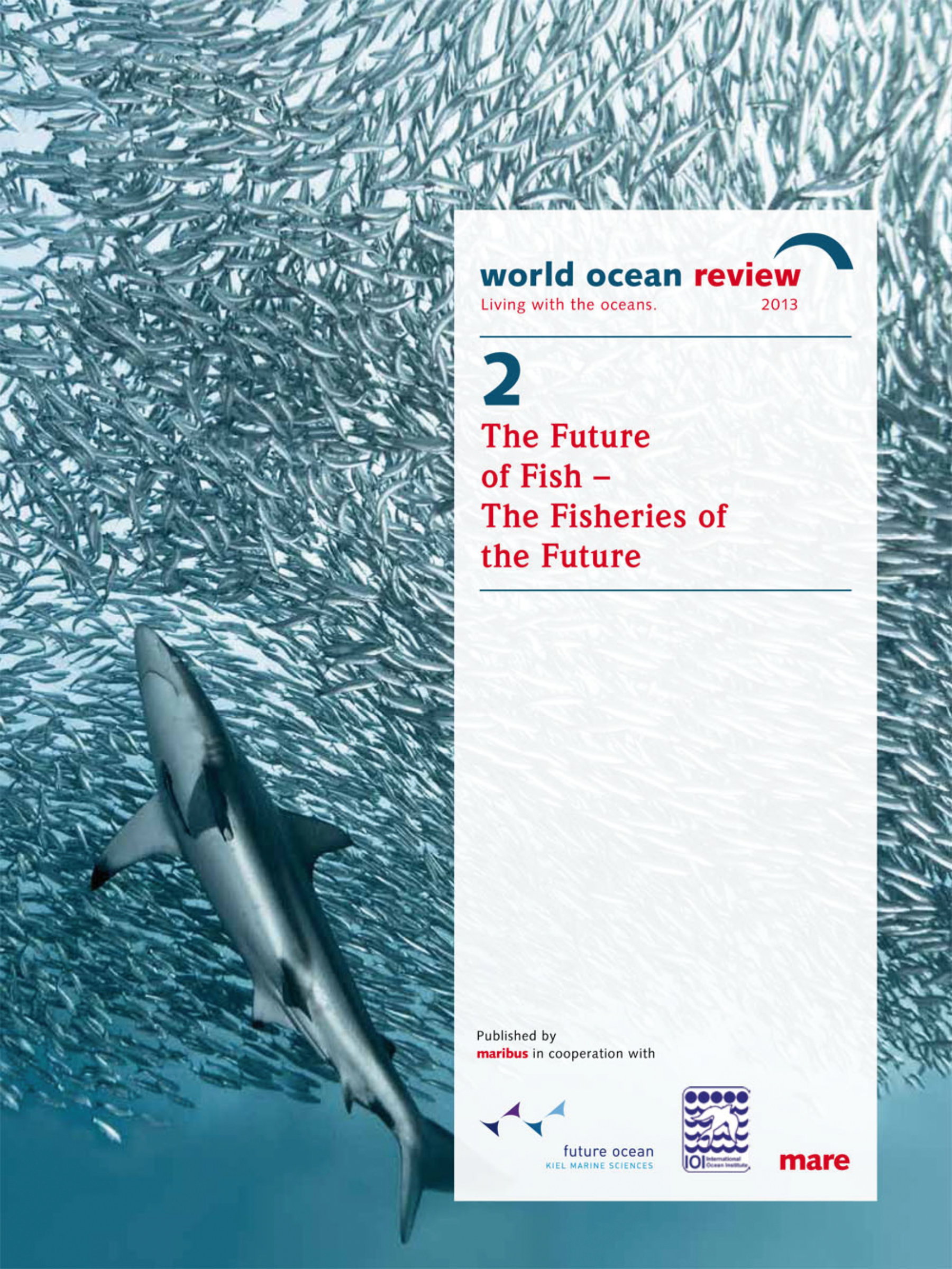
References
[1] http://www.un.org/sustainabledevelopment/sustainable-development-goals/
[2] Visbeck, M., Kronfeld-Goharani, U., Neumann, B., Rickels, W., Schmidt, J., van Doorn, E., Matz-Lück, N. und Proelss, A. (2014) A sustainable development goal for the ocean and Coasts: Global ocean challenges benefit from regional initiatives supporting globally coordinated solutions. Marine Policy, 49 . pp. 87-89. DOI 10.1016/j.marpol.2014.02.010.
[3] Visbeck, M., Kronfeld-Goharani, U., Neumann, B., Rickels, W., Schmidt, J., van Doorn, E., Matz-Lück, N., Ott, K. und Quaas, M. (2014) Securing Blue Wealth: The Need for a Special Sustainable Development Goal for the Ocean and Coasts Marine Policy, 48 . pp. 184-191. DOI 10.1016/j.marpol.2014.03.005.
[4] Ocean MOOCs at http://www.oceanmooc.org
[5] Sillmann, J., Lenton, T. M., Levermann, A., Ott, K., Hulme, M., Benduhn, F. und Horton, J. B. (2015) COMMENTARY: No emergency argument for climate engineering Nature Climate Change, 5 (4). pp. 290-292.
[6] Proelss, A. (2012) Geoengineering and International Law, in: Security and Peace Vol. 30, No. 4, pp. 205-211, DOI: 10.5771/0175-274x-2012-4-205
[7] Bordbar, M. H., Martin, T., Latif, M. und Park, W. (2015) Effects of long-term variability on projections of twenty-first century dynamic sea level Nature Climate Change, 5 (4). pp. 343-347. DOI 10.1038/nclimate2569.
[8] Halpern, B.S., Longo, C., Hardy, D., McLeod, K.L., Samhouri, J.F., Katona, S.K., Kleisner, K., Lester, S.E., O'Leary, J., Ranelletti, M., Rosenberg, A.A., Scarborough, C., Selig, E.R., Best, B.D., Brumbaugh, D.R., Chapin, F.S., Crowder, L.B., Daly, K.L., Doney, S.C., Elfes, C., Fogarty, M.J., Gaines, S.D., Jacobsen, K.I., Karrer, L.B., Leslie, H.M., Neeley, E., Pauly, D., Polasky, S., Ris, B., St Martin, K., Stone, G.S., Sumaila, U.R., Zeller, D. (2012) An index to assess the health and benefits of the global ocean, Nature, 488 (7413), pp. 615-620, DOI 10.1038/nature11397.


